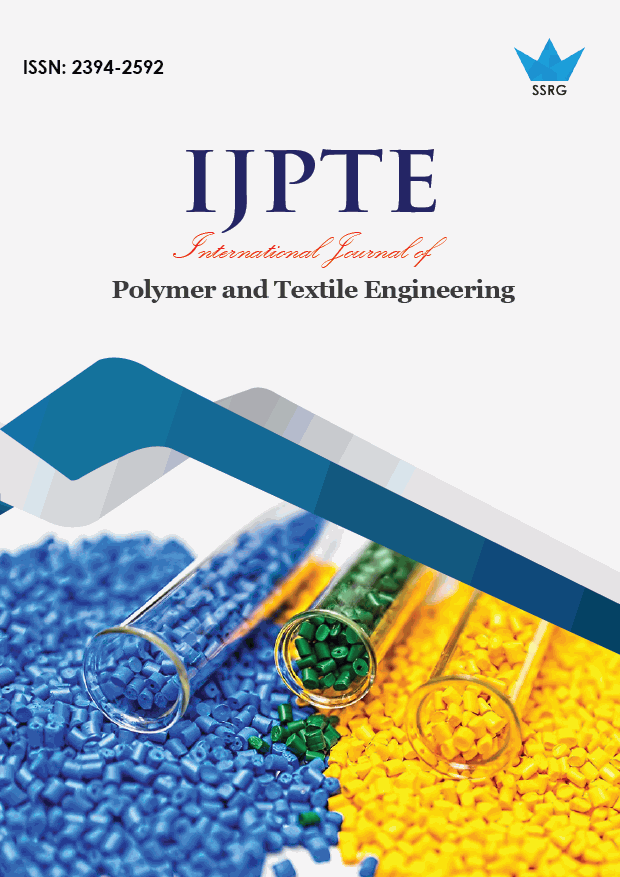Knit Structure and its Relationship to Dimensional Stability, Appearance Retention, Industrial Stretch, Pilling Resistance and Colorfastness to Crocking

| International Journal of Polymer and Textile Engineering |
| © 2019 by SSRG - IJPTE Journal |
| Volume 6 Issue 2 |
| Year of Publication : 2019 |
| Authors : Usha Chowdhary, Maruf Mohammed Adnan |
How to Cite?
Usha Chowdhary, Maruf Mohammed Adnan, "Knit Structure and its Relationship to Dimensional Stability, Appearance Retention, Industrial Stretch, Pilling Resistance and Colorfastness to Crocking," SSRG International Journal of Polymer and Textile Engineering, vol. 6, no. 2, pp. 1-8, 2019. Crossref, https://doi.org/10.14445/23942592/IJPTE-V6I2P101
Abstract:
The study examined selected performance attributes of three knit structures in different fiber contents. Several AATCC and ASTM standards were used to compare interlock, jersey and pique knits. Both descriptive and inferential statistics were used to analyse the data. Analysis of variance (ANOVA), t-tests, and descriptive statistics were used to analyse the data. Findings revealed that textiles in different fiber contents and structures did not perform similarly for the selected performance attributes. Possibilities for future extension and relevance of the yielded results was highlighted. Implications of the findings refining and extending the existing knowledge of textile and apparel manufacturers, retailers, and consumers for care, comfort and appearance were highlighted.
Keywords:
knit structure, appearance retention, colorfastness to crocking, dimension stability, pilling resistance, stretch
References:
[1] G. Agarwal, L. Koehl, and A. Perwuelz. ―Interaction of wash-ageing and use of fabric softener for drapeability of knitted fabrics‖. Textile Research Journal, Volume 81, No. 11, 1100-1112, 2011.
[2] U. Chowdhary Comparing three brands of cotton t-shirts.‖ AATCC Journal of Research, vo. 4, no. 3, 22-33, 2017. DOI: 10.14504/ajr.4.3.3.
[3] S. B. Marsha, and U. Chowdhary.‖ Comparison of Selected Structural and Performance Attributes of Cotton and Cotton/Polyester Blend T-Shirts.‖ SSRG International Journal of Polymer and Textile Engineering, vol. 5, no. 3, 40-49, 2018.
[4] A. Telli, and N. Ozdil. ―Effect of recycled PET Fibers on the performance properties of knitted fabrics‖. Journal of Engineered Fibers, and Fabrics,vol.10, no. 2, 47-60, 2015.
[5] H. Rahman, P.K. Biswas, B.K Mitra, and M.S.R. Rakesh. ―Effect of enzyme wash (cellulase enzyme) on properties of different weft knitted fabrics.‖ International Journal of Current Engineering and Technology, col. 4, no. 4, 4242-4248, 2014.
[6] S. Yesmin, M. Hasan, M. S. Mia, F. Momotaz, M.A., Idris, and M.R. Hasan. ―Effect of Stitch Length and Fabric Constructions on dimensional and mechanical properties of knitted fabrics‖. World Applied Sciences Journal, vol. 32 no.9, 1991-199, 2014
[7] G. Singh, K. Roy, R. Varshney, and A. Goyal, ―Dimensional parameters of single jersey cotton knitted fabrics‖. Indian Journal of Fibre and Textile Research, vol. 36, no.2, 111-116, 2011.
[8] D. Uttam, and R. Sethi, ―Impact of repeated washing on dimensional stability and physical factors of cotton woven fabric.‖ International Journal of Research in Engineering and Applied Sciences. vol., 6 no.2, 126-135, 2016.
[9] M. Akgun, B. Becerir, & H. R. Alpay. ―Abrasion of polyester fabrics containing staple weft yarns: Color strength and color difference values‖. AATCC Review, vol. 6, no. 3, 40-43, 2006.
[10] S.D. Kretzschmar, A. T. Özgüney, G. Özçelik, and A. Özerdem, the comparison of cotton knitted fabric properties
made of compact and conventional ring yarns before and after the dyeing process.‖ Textile Research Journal, vol. 77, no. 4, 233-241, 2007.
[11] L. Li, M. Zhu, and X. Wei. ―Pilling performance of cashmere knitted fabric of woolen ring yarn and mule yarn‖. Fibers and Textiles in Eastern Europe, vol. 22 no.1, 74-75, 2014.
[12] S. Omeroglu and S. Ulku. “An investigation about tensile strength, pilling and abrasion properties. of woven fabrics made from conventional and compact ring-spun yarns‖. Fibers and Textiles in Eastern Europe, vol. 15 no.1, 57-63, 2007.
[13] S. K. Smriti, and M.A. Islam. ―An exploration on pilling attitudes of cotton polyester blended single Jersey knit fabric after mechanical singeing‖. Science Innovation, vol. 3, no. 1, 18-21, 2015
[14] M. Zubair, H.S. Maqsood, and B. Neckar. ―Impact of filling yarns on woven fabric performance‖. Fibers and Textiles in Eastern Europe, vol. 24 no. 5, 50-54, 2016.
[15] Y. Can. ―Pilling performance and abrasion characteristics of plain-weave fabrics made from open-end and ring spun yarns.‖ Fibres and Textiles in Eastern Europe. Vol. 16, no., 81-84, 2008.
[16] TA. Tamanna, N. M. Suruj-Zaman, B. V. Mondal, and P. K. Saha ―Investigation of stretch and recovery property of weft knitted regular rib fabric. European Scientific Journal 13: 400-412, 2017.
[17] U. Chowdhary. ―Stretch and recovery of jersey and interlock knits‖. International Journal of Textile Science and Engineering, vol. 112, no. 1, 1-8, 2018.
[18] S.K. Kundu and U. Chowdhary.‖Effect of Fiber Content on Comfort Properties of Cotton/Spandex, Rayon/Spandex, and Polyester/Spandex Single Jersey Knitted Fabrics‖. SSRG International Journal of Polymer and Textile Engineering, vol. 5, no. 3, 33-39, 2018.
[19] R. S. Merkel. Textile product serviceability. New York, NY: Macmillan, 1991.
[20] S. J. Kadolph, and A. L. Langford Textiles. Upper Saddle River, NJ: Prentice Hall, 2002.
[21] U. Chowdhary,Textile analysis, quality control and innovative uses. New York, NY: LINUS. 2009

 10.14445/23942592/IJPTE-V6I2P101
10.14445/23942592/IJPTE-V6I2P101